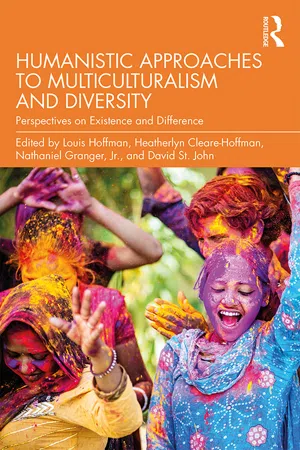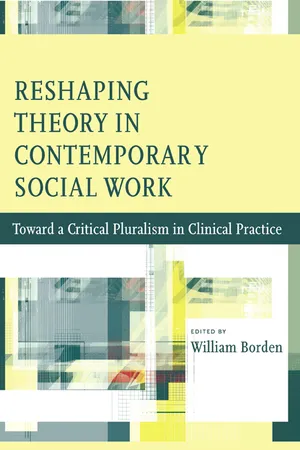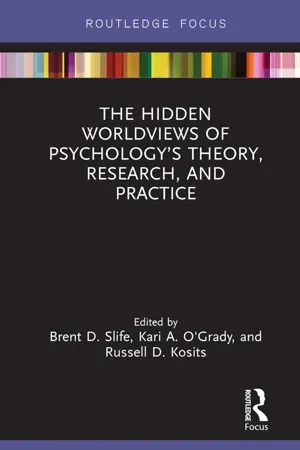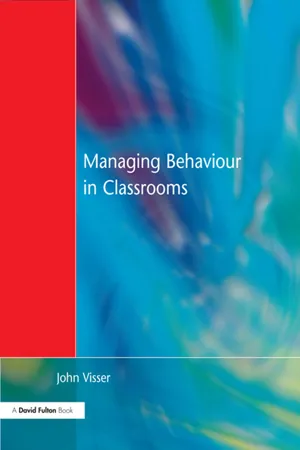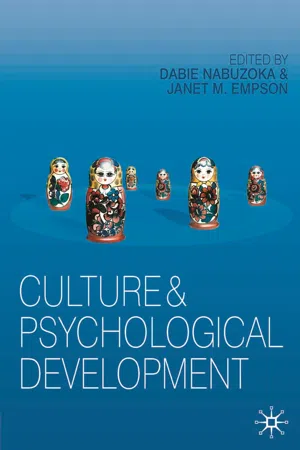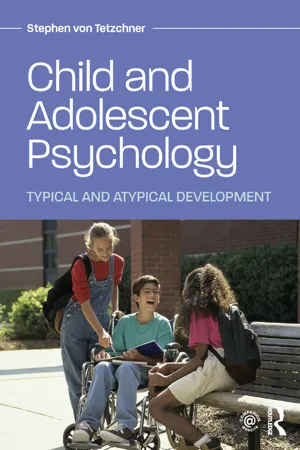Psychology
Multiple Perspectives in Psychology
Multiple perspectives in psychology refer to the various theoretical approaches and frameworks used to understand human behavior and mental processes. These perspectives include biological, cognitive, behavioral, psychodynamic, humanistic, and sociocultural viewpoints, each offering unique insights into the complexities of the human mind and behavior. By considering multiple perspectives, psychologists can develop a more comprehensive understanding of psychological phenomena.
Written by Perlego with AI-assistance
Related key terms
9 Key excerpts on "Multiple Perspectives in Psychology"
- eBook - ePub
Early Childhood Studies
A Social Science Perspective
- Ewan Ingleby(Author)
- 2012(Publication Date)
- Bloomsbury Academic(Publisher)
The schools of psychologyOne answer to this question is that there is no definite answer. Philosophers have speculated for hundreds, perhaps thousands, of years about what has come to be known as ‘the mind-brain problem’. Whether you focus upon the mind or the brain depends upon your fundamental understanding of how psychology should be studied. Many psychological perspectives such as behaviourism, humanism, psychodynamic and cognitive theories emphasize the importance of the mind. This is because each of these perspectives has a clear understanding or model of the mind. In contrast biological perspectives are more likely to place an emphasis upon the genes and hormones influencing the brain.We can now look at exploring some of the psychological perspectives. This is a way of adding detail to our introductory explanations of what the subject area of psychology is. It is also a means of setting the scene before we look at how psychology can be applied to early years practice and Early Childhood Studies in particular.Table 1.1 gives a summary of five major schools of psychology together with a brief description of their key features.These schools of thought are especially useful to practitioners working with children and families because of the influence they have had in shaping the academic concerns of psychology. The practical application of this academic discipline appears to relate to much of the work that is undertaken with children and families. If you are working with children and families you will need to apply psychology through ‘modelling’ best practice and meeting the needs of children and families in an assertive manner. Knowledge and understanding of the competing perspectives in psychology can help you to achieve this ‘best practice’. The origins of the schools of thought go back to some of the earliest philosophical ideas to have influenced Western thought. The proposition that there are forces beyond the individual that shape social reality goes back to the ideas of the Greek philosopher Plato. This idea is central to behaviourism so the perspective has its intellectual origins in this classical thought. The notion that individuals interpret their social world as opposed to being ultimately shaped by this world goes back to the ideas of Aristotle (Audi, 1995). This philosophy is of central importance to humanism. In other words the genesis of the perspective’s dominant idea can be traced back to these early times. A summary of each of the key perspectives developing the definitions given in Table 1.1 - eBook - ePub
Humanistic Approaches to Multiculturalism and Diversity
Perspectives on Existence and Difference
- Louis Hoffman, Heatherlyn Cleare-Hoffman, Nathaniel Granger, Jr., David St. John, Louis Hoffman, Heatherlyn Cleare-Hoffman, Nathaniel Granger, Jr., David St. John(Authors)
- 2019(Publication Date)
- Routledge(Publisher)
Paul Pedersen (1999) among many others argued that multiculturalism is the “fourth force” in psychology, which represents a fundamental paradigm shift in the way we think about human experience and behavior. Culture is broadly defined by Pedersen (1999) as “any and all potentially salient ethnographic, demographic, status, or affiliation identities” (p. 3), which thus includes race, ethnicity, spirituality, language, sexual orientation, physical issues, age, socioeconomic status and any group that share an affiliation for some common aspect of identification. Multicultural psychology is defined as the systematic study of human behavior as it takes place in settings in which individuals of different cultural backgrounds interact or have contact with one another (e.g., Bochner, 1999). Multicultural psychology has grown in prominence with the growing recognition that diversity characterizes the human condition and as the populations in most of the world’s countries have experienced a rapidly increasing diversification, due to economic globalization and various migration forces. The central assertion of multicultural psychology is that all aspects of human behavior are learned and expressed in a cultural context and, to comprehensively and accurately understand a person’s experience or behavior, it is necessary to understand the cultural context.As an application of multicultural psychology to the clinical setting, Sue, Ivey, and Pedersen (1996) proposed some basic assumptions of multicultural counseling and therapy. Chief assumptions assert that therapist and client identities are formed and embedded in multiple levels of biopsychosocial experiences and contexts. These identities then shape attitudes toward oneself and others, and are impacted by cultural status dynamics. They posit that the efficacy of therapy is enhanced when the therapist uses modalities and defines goals consistent with the client’s life experiences and cultural values, and that there are multiple helping roles involving social units beyond the one-on-one dyad. Their approach emphasizes an expansion of consciousness that is contextual in orientation and draws from traditional healing practices from many cultures. The paradigm shift offered by multicultural psychology is evidenced by the various divisions of the American Psychological Association (APA) that are now concerned with diversity issues (Divisions 9, 17, 27, 35, 36, 44, 45, 48, and 51). As well, APA’s Ethical Principles of Psychologists and Code of Conduct (APA, 2002) now contain a General Principle E that recommends that psychologists - eBook - ePub
Reshaping Theory in Contemporary Social Work
Toward a Critical Pluralism in Clinical Practice
- William Borden(Author)
- 2009(Publication Date)
- Columbia University Press(Publisher)
INTEGRATIVE PERSPECTIVESIn the field of cognitive psychology, Michael Mahoney has emphasized the importance of cross-theoretical dialogue, exemplifying the pluralist point of view in the development of his constructivist perspective (1995). Donald Meichenbaum has engaged a range of thinkers in fashioning his cognitive-behavioral models of intervention, emphasizing the role of subjective experience, narrative process, and personal meaning (1995). In the humanistic tradition, Leslie Greenberg has brought a depth of understanding and practical flexibility to the development of his experiential psychotherapy, drawing on psychodynamic, cognitive, and behavioral perspectives (2002). Although the foregoing thinkers have introduced distinctive points of view, they demonstrate the importance of dialogue across the therapeutic traditions in pragmatic consideration of ideas and methods, making pluralism a central feature of their work.Growing appreciation of the strengths and limits of the differing schools of thought has deepened interest in integrative conceptions of psychosocial intervention, and thinkers have drawn on psychodynamic, behavioral, cognitive, humanistic, and ecological theories in their attempts to apply a wider range of technical procedures, identify common elements that sponsor change, and develop unified conceptions of personality, psychopathology, and therapeutic action. In this section I expand earlier accounts of integrative perspectives (Borden, 2008b) and briefly consider the preceding case example in light of differing concerns explored in each line of inquiry.TECHNICAL ECLECTICISMThree perspectives have shaped attempts to integrate theory, empirical findings, and technical procedures in the field of psychotherapy. These are broadly categorized as technical eclecticism, common factors approaches, and theoretical integration (Arkowitz, 1992; Goldfried & Norcross, 1995). In each approach thinkers attempt to strengthen practice by looking beyond the bounds of single schools of thought, but they emphasize differing domains of phenomena and levels of analysis in attempts to facilitate change and improve outcomes. I describe the defining features of each perspective and identify exemplars associated with the approaches.In this form of integration clinicians apply technical procedures pragmatically on the basis of presumed efficacy (Arkowitz, 1992; Safran & Messer, 1997). Practitioners match specific methods with circumscribed problems in functioning on the basis of empirical evidence and clinical knowledge; in a prescriptive version of this approach, clinicians employ standardized treatment protocols linking particular diagnostic categories and specific procedures that have been validated in controlled clinical trials. For example, empirical findings and clinical experience provide evidence for the effectiveness of behavioral and cognitive procedures in treatment of problems in functioning associated with posttraumatic stress disorders and borderline personality organization. Clinical researchers frequently outline procedures in manuals that guide application of specific techniques over the course of intervention. - Brent D. Slife, Kari A. O'Grady, Russell D. Kosits, Brent D. Slife, Kari A. O'Grady, Russell D. Kosits(Authors)
- 2017(Publication Date)
- Routledge(Publisher)
recognizes and nurtures the diverse worldviews of its members, employing this diversity to improve science, and providing space to explore the possible connections between those worldviews and psychological thought and practice. The latter half of this chapter offers some initial concepts which we hope will advance the conversation on world-view pluralism within psychology, and, finally, within the viewpoint diversity movement itself. The chapter must begin, however, with an account of the significant obstacles which both impede and necessitate worldview pluralism.A Certain Blindness in Human Beings—and the Difficulty of Worldview Pluralism
In this account of the obstacles to worldview pluralism, we may start with one of North America’s greatest psychologists of belief, William James (1890), who began his treatment of the subject with a common intuition: “everyone knows the difference between imagining a thing and believing in its existence, between supposing a proposition and acquiescing in its truth” (p. 283). In the domain of worldview beliefs, it is one thing to “suppose”—either on a conscious or merely intuitive level—ontological, ethical, or epistemological propositions, such as “material reality is all there is,” or “psychology should adopt the position of worldview pluralism,” or “operational definitions can provide legitimate insight in to psychological phenomena”; it is quite another to believe them. How do we know whether we believe them or not? James insisted, quite plausibly, that it’s a matter of feeling . Belief is “a sort of feeling more allied to the emotions than anything else” (p. 283). Indeed, James refers to “the emotion of belief” (p. 284). When a proposition arouses “the believing reaction” (p. 305), we consciously or intuitively perceive that proposition to be real, or true. Hence, he called belief “the perception of reality” and his account of belief in the Principles of Psychology- eBook - ePub
- John Visser(Author)
- 2013(Publication Date)
- Routledge(Publisher)
There are multitudes of religious and cultural explanations for behaviour. The ability to shed insight upon understanding behaviour relies more here than for other perspectives on the degree to which the belief and values espoused by a particular religious/cultural perspective are in accord with the person seeking to understand the behaviour. If his or her view of humanity accords with, for example, the Christian notion of original sin, the management of behaviour by a teacher within the classroom may well rely upon strategies that inculcate these beliefs in pupils to the extent that they adopt certain behaviour patterns rather than others. There will also be more overt expectations of certain behaviour patterns.The psychological perspectiveThe predominant perspective for understanding behaviour within an education context is that of the psychological. This perspective divides into a number of sub-perspectives each having their own apologists. Ayers et al. (1995) give four broad sub-perspectives which are a useful framework for understanding the psychological perspective. They are:- behavioural;
- cognitive-behavioural;
- ecosystemic;
- psychodynamic.
Ayers et al. (1995) provide excellent introductions to these perspectives. In this short volume there is only space to briefly mention their salient features.The behavioural perspective
The behavioural perspective treats behaviour as a learnt response to stimuli. It considers only the observable part of behaviour, and works from the premise that only the observable is knowable. Assessment of behaviour is via checklist and observation schedules. From a behaviourist viewpoint, challenging behaviour is caused by maladaptive learning that results in incorrect responses to stimuli or poor stimuli that provoke the wrong responses. To change this behaviour the behaviourist will advocate programmes aimed at obtaining more appropriate responses from the stimuli given. In managing behaviour in classrooms this perspective would seek to negotiate contracts with pupils, and would establish reward systems which were linked to reinforcement programmes. Leading proponents of this understanding of behaviour and its implications for teachers are Kazdin (1994) Merrett (1993) and Wheldall (1992). - Dominic Upton(Author)
- 2013(Publication Date)
- Routledge(Publisher)
In spite of its shortcomings, the humanistic approach has helped bring the ‘person’ back into psychology. It recognises that people determine their own behaviour and are not simply slaves to environmental contingencies or to their past (Gross and Kinnison, 2007). However, the greatest contribution of humanistic psychology may lie in its encouragement of humane and ethical treatment of persons, approaching psychology and healthcare as a human science rather than a natural science. Nonetheless, it is suggested that in order for us to understand human behaviour in a complete and multidimentional way it is imperative that researchers adopt a combination of psychological approaches (Henriques, 2011).2.21 ConclusionContemporary psychology is a complex multidisciplinary subject characterised by a range of different approaches. Given their different assumptions the approaches are sometimes in conflict. Proponents of one approach often criticise the naïve interpretations and treatment efforts of others, yet no approach is complete in itself.Each approach focuses mainly on one aspect of human functioning and none can explain all aspects of behaviour. Ultimately it is up to you, the nurse, to decide which approach makes best sense to you in the context of the situation you are faced with. According to Raudonis and Acton (1997: 138):Theory provides nurses with a perspective with which to view client situations, a way to organise the hundreds of data bits encountered in the day-to-day care of clients, and a way to analyse and interpret the information. A theoretical perspective allows the nurse to plan and implement care purposefully and proactively. When nurses practise purposefully and systematically, they are more efficient, have better control over the outcomes of their care, and are better able to communicate with others- eBook - ePub
- Dabie Nabuzoka, Janet Empson, Dabie Nabuzoka, Janet Empson(Authors)
- 2009(Publication Date)
- Bloomsbury Academic(Publisher)
Cultural psychology is thus different from cross-cultural (comparative) psychology in terms of approaches to studying influences on development and the predominant methods used. For example, one perspective of cultural psychology considers culture in terms of the creation of an environment to which children (as young organisms) are provided conditions for optimal growth. Thus, in one respect, culture is regarded as a medium for development (Cole, 1992). This represents a molar approach to the study of environmental influences on human development. The approach of cross-cultural psychology, however, is more molecular. Here, the interest is not on culture in its totality as such but on the relationship between behaviour and elements of culture (e.g., socialization, ecological features, etc.). It has been pointed out that, in this approach, identifying cross-cultural differences amounts to identifying cultural elements behind the differences (Segall, 1984; van de Vijver and Poortinga, 2002).2.2.3 Indigenous psychology
Indigenous psychology has been described as a set of approaches to understanding human behaviour within the cultural contexts in which they have developed and are currently displayed. In addition, they have been described as attempts to root psychological research in the conceptual systems that are indigenous to a culture, including the philosophical, theological and scientific ideas that are part of the historical and contemporary lives of people and their institutions (Allwood and Berry, 2006a; 2006b). According to Miller and Chen (2000), ‘indigenous psychological approaches share a concern with understanding developmental processes in terms of concepts, norms, values, practices, and life circumstances found in particular cultural settings’ (p. 1 ).The rationale for advocating indigenous approaches in developmental psychology has included a number of concerns about the theoretical and empirical bases of existing approaches in the discipline (Nsamenang, 2000; Sinha, 1997). For example, Nsamenang (2000) pointed out that the database and norms regarding human development in mainstream psychology are based largely on limited and unrepresentative samples from highly industrialized nations. As such, the discipline cannot claim to be universal and scientific. In addition, non-Western perspectives are few and are rarely incorporated in the discipline in terms of its paradigms and key concepts. A key argument is therefore that psychology as a discipline has been dominated by the Euro-American image of childhood without any questioning of its relevance to realities and interests in non-Western contexts. - eBook - ePub
Education and Psychology in Interaction
Working With Uncertainty in Interconnected Fields
- Brahm Norwich(Author)
- 2002(Publication Date)
- Routledge(Publisher)
This line of argument leads us to ask why such a premium is placed on the causal scientific rather than the hermeneutic knowledge mode. The obvious answer is that the dominance of the causal mechanistic model arises from the strong bias towards knowledge structured in terms of the technical interest in predicting and controlling outcomes. And, as the discussion in this and previous chapters has indicated, this is where we need to take account of the academic position of psychology in universities and the professional interest of its practitioners in acquiring and retaining expert scientific status. One conclusion to draw from this discussion is that co-existence does not mean that tensions are resolved and explanatory harmony has been achieved. Coexistence is more a matter of tolerance and a capacity to understand the rationale of different traditions. It is a call for an appreciation of the connections between different psychological traditions.However, these are idealised reconnections between different traditions in psychology. In practice, there has been a threat to psychology by the growth of multi-disciplinary fields like cultural studies, cognitive sciences, neurosciences and social sciences, which have shown up the divisions within psychology. There have been calls for the construction of a coherent discipline of psychology, not in opposition to such multidisciplinary collaboration, but so as to unite the cognitive, emotional, social and biological aspects of human functioning. The case for this is not based on nostalgia for a lost ideal, but on doing justice to a comprehensive and integral account of the multiple aspects of human experience and actions. The construction of such a framework, it is argued, depends partly on a methodological integration between different experimental and quantitative methods and interpretive and qualitative ones. Such a methodological integration can also be seen to be important for bridging the gap between basic research psychologists and professional applied psychologists.It seems unlikely that research in basic psychology can thrive completely isolated from the practical problems encountered in everyday life and by professional psychologists. It has been noted that the social sciences (and this includes psychology) are essentially applied sciences in the sense, as Marx put it, that they are there to change the world, not just to interpret it (Hobsbawm, 1997). The idea that the basic researcher in psychology is a simple seeker after the pure academic truth, whether or not it interests anyone outside the field, can be attributed to the growth of the academic profession in separate institutions. It might also have something to do with a process of mystifying people outside academia. There is much influence to be gained by presenting the outcomes of research and scholarship as secure and unchallengeable knowledge that is developed by a group which stands outside policy and practice differences. - eBook - ePub
Child and Adolescent Psychology
Typical and Atypical Development
- Stephen von Tetzchner(Author)
- 2018(Publication Date)
- Routledge(Publisher)
2 THEORETICAL PERSPECTIVESThis chapter provides a brief introduction to the foundations of theory formation and the most important theoretical perspectives in developmental psychology: psychodynamic psychology, behaviorism, logical constructivism, social constructivism, evolutionary psychology, ethological psychology, ecological psychology, information processing and critical psychology. They differ in their emphasis and explanations of developmental phenomena and together they illustrate the breadth of developmental thinking in the twenty-first century. Each of them comprises many assumptions and hypotheses, and constitutes a basis for many smaller theories.The theories are presented in more detail in parts of the book where they are relevant, including critical comments. Chapter 10 , for example, discusses the cognitive aspects of the theories, while Chapter 18 discusses the development of personality.THE FUNCTION OF DEVELOPMENTAL THEORIES
Developmental theories are intellectual tools for categorizing and making sense of observations of children’s actions and reactions and their environment, and explaining typical and atypical developmental trajectories. As all tools, they must be functional and solid. A good theory requires a coherent set of interconnected concepts and a terminology that can be used to describe the development of the psychological phenomena and explain the relevant processes, for example concepts that can characterize children’s changing thinking or emotion understanding, and the processes that underlie these developmental changes (see Chapters 10 and 17 ). “The usefulness of theories may be evaluated in regard to its attributes of precision, scope and deployability” (Lerner, 2002, p. 11).According to Popper (1959), a theory has to be testable in order to be scientific. The first test of whether a theory is sound and tenable is to establish if it can account for and integrate existing research findings (Lerner, 2002). Popper also points out that theories cannot be proven
Index pages curate the most relevant extracts from our library of academic textbooks. They’ve been created using an in-house natural language model (NLM), each adding context and meaning to key research topics.

